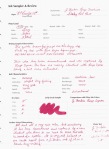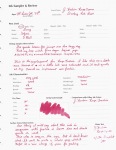
QV Septanote, Principal, Student, University
(click to enlarge or sharpen images)
The school year is now in full swing or close to it for many of us students, teachers, professors, and school administrators. I always like to start the school year off right by getting my schedule together and jump-starting organization plans for the year.
Now, being the inkophile and fountain pen lover that I am, I like a paper planner. I use Quo Vadis planners because I love the Clairefontaine paper in them, and I think they offer some of the most functional planner layouts on the market.
Today, I’ll be taking a look at 4 different Quo Vadis Planners: two desk-sized (Septanote and Principal) and two pocket-sized ( University and Student). I apologize in advance for the length of this blog post, but I’m trying to get through a lot of material here. There’s a giveaway at the end, so don’t forget to enter to win you own Quo Vadis Planner!
SEPTANOTE:
Now, this was the planner I used last school year. I LOVE IT! I was able to get this one at my school’s bookstore (how great is that?!). This planner is desk sized at 7 1/4″ x 9 1/2″. The paper is 90g Clairefontaine paper, and it comes in 3 different covers: Club, Soya, and Vinyl. The covers are refillable. Below is a picture of the planner page layout and one that shows how I used it last year:

QV septanote as used by me

Septanote Layout
As you can see, this one is intended for you to do some major major planning. For Monday-Saturday there is enough room to plan out all your meetings and obligations from 8am to 9pm. At the top of each day section is a place to note that day’s priority and at the bottom of each day section is a place for additional notes. On the far right are the following sections: phone, fax/email, see/do, pay/receive, and Sunday’s planning section. At the top on the far right you will find 3 mini monthly calendars, indication of the quarter, and the number week you are in.
As with most Quo Vadis planners, the Septanote comes with an abundance of extras: international phone code list, average temperatures around the world, notes sections at the front and back, year at a glance annual planning pages for the present and next school years, several maps, 3 yearly calendars, and a phone book insert.
The Vinyl Septanote sells for about $22, but you can usually find them for much less.
The standard year format of this planner is called the Trinote.
PRINCIPAL:
This school year is not going to be quite as hectic as the last, so I’m trying out a Quo Vadis Principal. The Principal comes in 5 different covers: Club, Soya, Nappa Leather, Chelsea Leather, and Vinyl. The covers are refillable. It is about the same size as the Septanote at 7″ x 9 3/8″, and has the same 90g paper, but the planning pages are much different:

QV Principal Layout
You still get a week at a glance, but the days are setup differently. For each day you still have space to note appointments between 8am and 9pm and each day had a section for additional notes. But, unlike the Septanote, the Principal gives each day its own dedicated sections for phone, email, and to-dos. With that, each day is fully contained in its own section. There are no shared sections. At the bottom left you have 3 larger monthly calendars along with an indication of the number week you are in.
The thing I like most about the Principal is that each day is self-contained while still keeping the events of the week together. However, there is some trade-off here. Namely, you do not get as much room for planning as you get with the Septanote, but if your weeks are a bit less hectic this might just be the desk sized planner for you.
The extras for this one include: Mon-Sat 8am-9pm master weekly schedule, year at a glance annual planning pages for the present and next school years, chart of international holidays, international phone code list, average temperatures around the world, several maps, 3 yearly calendars, and a phone book insert.
The Vinyl Principal sells for about $19, but you can find them for less.
Writing samples for desk-sized planners:

QV 90g writing sample

QV 90g very little show through
UNIVERSITY:
The Quo Vadis University is a pocket-sized planner at 4″ x 6″. This planner comes with a free Quo Vadis elastic band bookmark, and comes in 5 different covers: Club, Soya, Habana, Robert le Heros, and Vinyl. As you can see from the image below, it has almost the exact same planning format as the larger Septanote:

QV University Layout
However, there are several differences between this planner and its larger sibling. The biggest difference is the paper. Whereas the Septanote has 90g paper, the University has 64 g paper. The 64 g paper still performs quite well with fountain pens (see the image below). It is resistant to feathering and bleed through, but you do get more show through. You can still write on both sides of the page, just know there will be shadowing. Although this paper can handle wet wide nibs, I strongly recommend that you stick with medium nibs or finer in order to get the best results. Another difference between this and the Septanote is that you lose a notes section for each day though there is a general notes section to the far right. In addition, the section for Sunday is now stretched along the bottom of the page. On the far right you still have sections for phone, email, pay/receive, and to-dos. The final difference is that the top right only shows one monthly calendar instead of three.
Despite these differences, I still see this pocket-sized academic year planner as perfect for someone who needs to do a lot of planning and/or is always on the go. There is more space for planning here than one would normally get out of a pocket planner. Because of this benefit, I will be using this planner as the pocket companion to my Quo Vadis Principal.
Extras for the Quo Vadis University include: chart of international holidays, 2 Mon-Sat 8am-9pm master weekly schedules, year at a glance annual planning pages for the present and next school years, time zone map, Map of the USA and Canada, one notes page, 2 yearly calendars, and a phone book insert.
The Vinyl Quo Vadis University sells for about $11 but you can find them for less.
The standard year version of this planner is called Quo Vadis Business.
STUDENT:
Last up for consideration is the Quo Vadis Student. The Student comes in 3 cover options: Club, Soya, and Vinyl. This pocket-sized planner (6 5/8″ x 3 1/2″) is a departure from the rest here. It covers 17 months instead of 13, it is two weeks at a glance instead of one week, and it is not so much a planner as it is a diary.

QV Student Layout
As you can see, there is one week on each page. You have room to write down appointments from 8am-7pm. There is a calendar at the bottom of each page and the number week at the top of the page.
This diary is bare-bones, and is good for those who only need a place to write down appointments, commitments, and deadlines. This one is also good for those who want to look at more than one week at a time.
The paper here is also 64g like the University, so it takes fountain pen ink just as well.
Extras include: notes page, year at a glance annual planning pages for 17 weeks (1.5 school years), 3 Mon-Sat 8am-9pm master weekly schedules, an integrated address book, a yearly calendar, and a separate address book (Yes, that’s a second address book. Why? I dunno…).
The vinyl Quo Vadis Student sells for around $12, but you can find them for less.
The standard year version of the Student is called the Quo Vadis Biweek.
Writing samples for pocket-sized planner:

QV 64g writing sample

QV 64g prominent show through but still usable
In addition to the 4 planners I’ve outlined here, Quo Vadis offers many more options in academic as well as standard year format. They make planners of varying sizes, formats, and paper weights. If you’d like more information about other planners they off please visit their website at http://www.quovadisplanners.com/ .
GIVEAWAY!!!
I’m not going to be using the Quo Vadis Student planner (w/ green Club cover), so what better to do with it than give it away to one of my readers?! Even if you don’t need an academic year planner I encourage you to enter anyway. The standard year version of this planner is quite similar and uses the same paper.
Here’s what you need to know:
- Click here and fill out the form.
- You must enter by 11:59pm EST on Sunday, September 12, 2010.
- The winner will be chosen by Random.org
- I’ll let you know who’s the lucky winner on Monday, September 13.
The Principal, University, and Student planners were sent to me by the good folks at Exaclair. I am not otherwise affiliated with them.
Tags: comparisons, giveaway, planner review, quo vadis












































